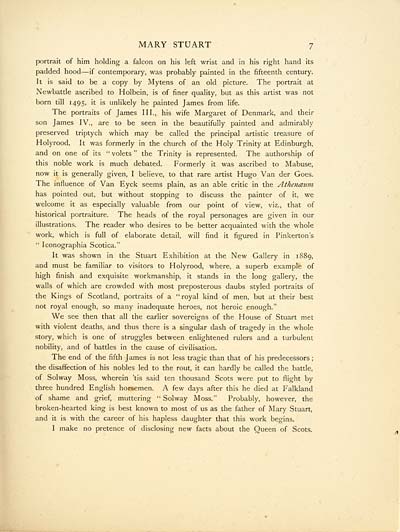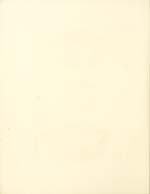Stuarts
(27) Page 7
Download files
Complete book:
Individual page:
Thumbnail gallery: Grid view | List view

MARY STUART 7
portrait of him holding a falcon on his left wrist and in his right hand its
padded hood — if contemporary, was probably painted in the fifteenth century.
It is said to be a copy by My tens of an old picture. The portrait at
Newbattle ascribed to Holbein, is of finer quality, but as this artist was not
born till 1495, it is unlikely he painted James from life.
The portraits of James III., his wife Margaret of Denmark, and their
son James IV., are to be seen in the beautifully painted and admirably
preserved triptych which may be called the principal artistic treasure of
Holyrood. It was formerly in the church of the Holy Trinity at Edinburgh,
and on one of its "volets" the Trinity is represented. The authorship of
this noble work is much debated. Formerly it was ascribed to Mabuse,
now it is generally given, I believe, to that rare artist Hugo Van der Goes.
The influence of Van Eyck seems plain, as an able critic in the Athenceum
has pointed out, but without stopping to discuss the painter of it, we
welcome it as especially valuable from our point of view, viz., that of
historical portraiture. The heads of the royal personages are given in our
illustrations. The reader who desires to be better acquainted with the whole
work, which is full of elaborate detail, will find it figured in Pinkerton's
" Iconographia Scotica."
It was shown in the Stuart Exhibition at the New Gallery in 1889,
and must be familiar to visitors to Holyrood, where, a superb example of
high finish and exquisite workmanship, it stands in the long gallery, the
walls of which are crowded with most preposterous daubs styled portraits of
the Kings of Scotland, portraits of a "royal kind of men, but at their best
not royal enough, so many inadequate heroes, not heroic enough."
We see then that all the earlier sovereigns of the House of Stuart met
with violent deaths, and thus there is a singular dash of tragedy in the whole
story, which is one of struggles between enlightened rulers and a turbulent
nobility, and of battles in the cause of civilisation.
The end of the fifth James is not less tragic than that of his predecessors ;
the disaffection of his nobles led to the rout, it can hardly be called the battle,
of Solway Moss, wherein 'tis said ten thousand Scots were put to flight by
three hundred English horsemen. A few days after this he died at Falkland
of shame and grief, muttering "Solway Moss." Probably, however, the
broken-hearted king is best known to most of us as the father of Mary Stuart,
and it is with the career of his hapless daughter that this work begins.
I make no pretence of disclosing new facts about the Queen of Scots.
portrait of him holding a falcon on his left wrist and in his right hand its
padded hood — if contemporary, was probably painted in the fifteenth century.
It is said to be a copy by My tens of an old picture. The portrait at
Newbattle ascribed to Holbein, is of finer quality, but as this artist was not
born till 1495, it is unlikely he painted James from life.
The portraits of James III., his wife Margaret of Denmark, and their
son James IV., are to be seen in the beautifully painted and admirably
preserved triptych which may be called the principal artistic treasure of
Holyrood. It was formerly in the church of the Holy Trinity at Edinburgh,
and on one of its "volets" the Trinity is represented. The authorship of
this noble work is much debated. Formerly it was ascribed to Mabuse,
now it is generally given, I believe, to that rare artist Hugo Van der Goes.
The influence of Van Eyck seems plain, as an able critic in the Athenceum
has pointed out, but without stopping to discuss the painter of it, we
welcome it as especially valuable from our point of view, viz., that of
historical portraiture. The heads of the royal personages are given in our
illustrations. The reader who desires to be better acquainted with the whole
work, which is full of elaborate detail, will find it figured in Pinkerton's
" Iconographia Scotica."
It was shown in the Stuart Exhibition at the New Gallery in 1889,
and must be familiar to visitors to Holyrood, where, a superb example of
high finish and exquisite workmanship, it stands in the long gallery, the
walls of which are crowded with most preposterous daubs styled portraits of
the Kings of Scotland, portraits of a "royal kind of men, but at their best
not royal enough, so many inadequate heroes, not heroic enough."
We see then that all the earlier sovereigns of the House of Stuart met
with violent deaths, and thus there is a singular dash of tragedy in the whole
story, which is one of struggles between enlightened rulers and a turbulent
nobility, and of battles in the cause of civilisation.
The end of the fifth James is not less tragic than that of his predecessors ;
the disaffection of his nobles led to the rout, it can hardly be called the battle,
of Solway Moss, wherein 'tis said ten thousand Scots were put to flight by
three hundred English horsemen. A few days after this he died at Falkland
of shame and grief, muttering "Solway Moss." Probably, however, the
broken-hearted king is best known to most of us as the father of Mary Stuart,
and it is with the career of his hapless daughter that this work begins.
I make no pretence of disclosing new facts about the Queen of Scots.
Set display mode to:
![]() Universal Viewer |
Universal Viewer | ![]() Mirador |
Large image | Transcription
Mirador |
Large image | Transcription
Images and transcriptions on this page, including medium image downloads, may be used under the Creative Commons Attribution 4.0 International Licence unless otherwise stated. ![]()
| Histories of Scottish families > Stuarts > (27) Page 7 |
|---|
| Permanent URL | https://digital.nls.uk/95239375 |
|---|
| Description | A selection of almost 400 printed items relating to the history of Scottish families, mostly dating from the 19th and early 20th centuries. Includes memoirs, genealogies and clan histories, with a few produced by emigrant families. The earliest family history goes back to AD 916. |
|---|

